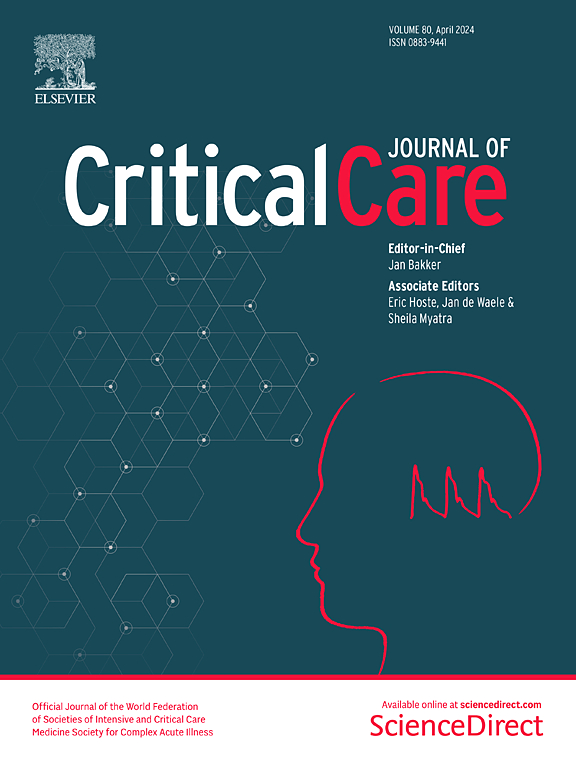分析无呼吸机天数的最佳方法是什么?模拟研究
IF 8.8
1区 医学
Q1 CRITICAL CARE MEDICINE
引用次数: 0
摘要
无呼吸机天数(vfd)是重症监护研究中的一个综合结果,反映了生存和机械通气时间。然而,vfd的分析方法并不一致,一些侧重于计数,另一些侧重于事件时间结果,而其他方法如多状态模型和胜率已经出现。我们的目的是通过模拟来评估各种统计模型,以确定分析vfd的最佳方法。首先,模拟了16组300人的数据集,比较了对照组和不同存活率和通气时间的干预组。评估各种统计模型的统计能力和I型错误率。4个临床试验数据集(LIVE研究,NCT02149589;ARMA研究,NCT00000579;ACURASYS研究,NCT00299650;然后使用NCT04344730),应用相同的统计模型分析vfd。评估了12种统计方法,包括基于计数的方法、事件时间方法和胜率方法。此外,还进行了敏感性分析。除了零膨胀和障碍泊松/负二项计数子模型以及死因特异性Cox回归模型外,大多数统计方法都能有效控制I型错误率。检测生存效益和通气时间影响的能力各不相同,时间-事件方法、Mann-Whitney检验、比例赔率模型和胜率通常表现最好。在敏感性分析中也观察到类似的结果。在实际数据集中,多状态模型、Mann-Whitney检验、比例赔率模型和胜率普遍显示vfd与随机分组之间存在显著关联。多状态模型可以被推荐为分析vfd的最佳方法,因为它优于其他方法,并且比比例赔率模型和胜率模型提供了更可解释的效应大小。本文章由计算机程序翻译,如有差异,请以英文原文为准。
What is the optimal approach to analyse ventilator-free days? A simulation study
Ventilator-free days (VFDs) are a composite outcome in critical care research, reflecting both survival and mechanical ventilation duration. However, analysis methods for VFDs are inconsistent, with some focusing on counts and others on time-to-event outcomes, while other approaches such as the multistate model and the win ratio have emerged. We aimed to evaluate various statistical models through simulations to identify the optimal approach for analysing VFDs. First, 16 datasets of 300 individuals were simulated, comparing a control group to an intervention with varying survival rates and ventilation durations. Various statistical models were evaluated for statistical power and Type I error rate. Four clinical trial datasets (LIVE study, NCT02149589; ARMA study, NCT00000579; ACURASYS study, NCT00299650; COVIDICUS study, NCT04344730) were then used to apply the same statistical models to analyse VFDs. Twelve statistical methods were evaluated, including count-based, time-to-event approaches, and the win-ratio. Additionally, sensitivity analyses were conducted. Most statistical methods effectively controlled Type I error rate, except for the zero-inflated and hurdle Poisson/negative binomial count submodels, as well as the cause-specific Cox regression model for death. The power to detect survival benefit and ventilation duration effects varied, with time-to-event approaches, the Mann–Whitney test, the proportional odds model and the win ratio generally performing best. Similar results were observed in sensitivity analyses. In the real datasets, the multistate model, the Mann–Whitney test, the proportional odds model and the win ratio generally showed a significant association between VFDs and randomisation groups. The multistate model could be recommended as the optimal approach for analysing VFDs, as it outperformed the other methods and offers a more interpretable effect size than the proportional odds model and the win ratio.
求助全文
通过发布文献求助,成功后即可免费获取论文全文。
去求助
来源期刊

Critical Care
医学-危重病医学
CiteScore
20.60
自引率
3.30%
发文量
348
审稿时长
1.5 months
期刊介绍:
Critical Care is an esteemed international medical journal that undergoes a rigorous peer-review process to maintain its high quality standards. Its primary objective is to enhance the healthcare services offered to critically ill patients. To achieve this, the journal focuses on gathering, exchanging, disseminating, and endorsing evidence-based information that is highly relevant to intensivists. By doing so, Critical Care seeks to provide a thorough and inclusive examination of the intensive care field.
 求助内容:
求助内容: 应助结果提醒方式:
应助结果提醒方式:


